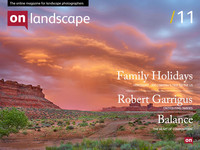Book reviews

Tim Parkin
Tim Parkin is a British landscape photographer, writer, and editor best known as the co-founder of On Landscape magazine, where he explores the art and practice of photographing the natural world. His work is thoughtful and carefully crafted, often focusing on subtle details and quiet moments in the landscape rather than dramatic vistas. Alongside his photography and writing, he co-founded the Natural Landscape Photography Awards, serves as a judge for other international competitions. Through all these projects, Parkin has become a respected and influential voice in contemporary landscape photography.
John Blakemore has taught photography for over two decades and has worked as a fine art photographer for that period also. This book tries to distil his teaching into a single tome, covering technical and artistic bases along the way. The fact that this isn't just a technical tome or an art philosophy tome works very well in my opinion and reflects the fact that these two aspects of photography cannot really be separated (however much many photographers would like to do so).
The first chapter of the book discusses the full process of photography in terms of John's categories of "Relationship, Recognition and Realisation" - our relationship with our subject, our recognition of the moment an exposure needs to be made and the realisation of the final product, the print. The second chapter takes this framework and discusses how it worked for John's most famous work, the tulip series.
For those of you who don't know the tulip work, John spent over a decade of his life developing a series of photographs based around the tulip, all of which started whilst avoiding writing his thesis by taking photographs of 'stuff' that was on his kitchen table. That such a successful and intriguing body of work can arise from something so trivial a start should remind us that any of our photographs might contain the germ of a creative project. Although this chapter isn't about landscape photography, it is still relevant in nearly all of its content.
Chapter three concerns itself with the zone system and the art of pre-visualisation (his admiration of Minor White shows in his use of that term) and a lot of this might be of less interest to digital photographers, the discussions about tonality are still relevant. There is still an orthodoxy in black and white conversions that there should always be black blacks and white whites in every picture, something John rejects in similar words and I have to say I am in complete agreement with. Some of the pictures that I find strongest in John’s work are those high an low key pictures that limit themselves to only two or three zones and that rarely contain what John terms ‘dead blacks’ (he has a phrase ‘dead blacks and living darks’ which summarises part of his approach to printing). Using some of these techniques on my own black and white conversions improved them considerably. Chapter four is about Post Visualisation, the making of the print and again this may not be of a whole lot of interest to digital photographers but there are some gems hidden in the content.
The final chapter returns to John’s discussion of subject development; developing a theme or series. This works as an almost free form discussion of John’s projects (apart from the tulip which was handled in more detail in chapter two), discussing his stream, beach and emergence series and then moving away from landscape and onto his still life work. This chapter is full of little gems and I gained as much from re-reading it for this review as I did when I originally read it a few years ago.
Overall the book is a fascinating melange of technical and philosophical, art and craft. It sits on my bookshelves in the art section despite being one of the better tomes on the zone system I have read. I would strongly suggest every photographer buy or borrow a copy and read it but more importantly think about it whilst doing so.
- John Blakemore Book Binding and Sequencing Workshop
- John Blakemore Master Photographer
- Photographs 1951-2010 – John Blakemore











